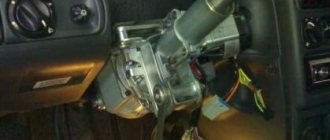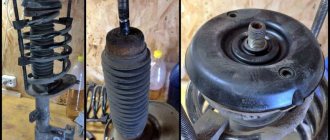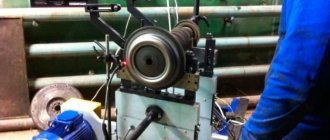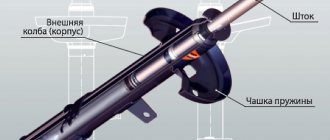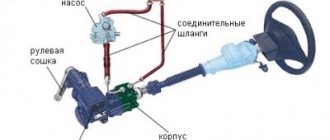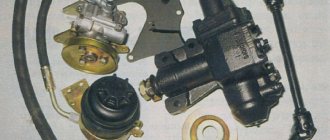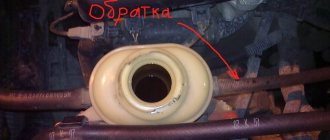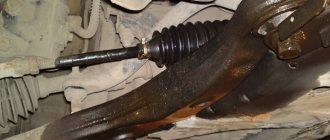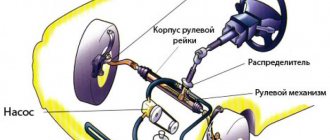In this article we will talk about the power steering system and structure, discuss the issue of replacing the power steering pump and modernization.
Those car enthusiasts who have driven a car for a long time without this device, and then switched to a foreign car with this function, will immediately notice a significant difference in control. Power steering helps solve several problems at once: the steering process no longer requires much effort, maneuverability increases and the turning trajectory is reduced.
As it turned out, the presence of a hydraulic booster in a car is a very positive thing, however, like other functions, there comes a time when the amplifier fails. The most common problems are: unpleasant noise when turning the steering wheel, leakage of hydraulic fluid, problems with the amplitude of the steering wheel and a significant deterioration in controllability.
Is it possible to drive with low power steering fluid level?
A leak that appears in the hydraulic booster system always manifests itself in the same way in stages.
At the first stage, with a slight lack of oil while turning the steering wheel, a sound resembling a howl or itching appears in the engine compartment. The sound occurs only when the engine is turned off, gradually fading away as the engine warms up. The steering wheel still turns quite easily.
The second stage of level reduction is characterized by an unabating hum, including when the engine is well warmed up. The hum is also heard when turning the steering wheel, but the steering wheel turns a little harder.
Finally, in the third stage, the steering wheel becomes even tighter and the sounds from under the hood disappear. This indicates that all the fluid has already left the power steering system. You can verify this by simply opening the tank lid and looking inside.
Remember! Lack of oil in the power steering will damage the pump, even if you drive only 5 km.
The power steering pump is not designed to operate completely without oil, and most often its rotor pair is damaged (bulged), which cannot be repaired. The only solution to the problem in this case is to purchase a new pump, the cost of which, as a rule, varies between 10-18 thousand rubles and even higher. It will cost significantly more to install a double-circuit pump on a car with hydraulic suspension. Here you will have to pay from 30 to 100 thousand rubles for a new unit.
In such a situation, it is better to use the service of a tow truck. You can try to fill the power steering reservoir with fluid to the minimum level and move around in this way, periodically adding oil as the reservoir becomes empty. However, the supply may not be enough, and then all that remains is to wait for the tow truck.
In the first two stages, despite the low fluid level in the power steering reservoir, you still have the opportunity to drive under your own power, focusing on the sound and compliance of the steering wheel. Until the steering wheel becomes completely stiff and the sound still accompanies its rotation, there is still enough oil in the system for the pump to operate.
It may happen that all the fluid has leaked out of the power steering, and there is no way to call a tow truck. At the same time, even topping up to the minimum level does not save the situation. Here, in order not to damage the pump, it should be completely turned off. The power steering pump in many cars is driven by a separate belt. Accordingly, to stop the pump, this belt should be carefully cut, making sure first that the belt drives only this unit and no other mechanisms will be affected.
Driving with the pump turned off is permitted. But you can drive in this mode no more than 500 km at a speed no higher than 45 km/h. The steering wheel will turn tightly, so it is advisable to drive as straight as possible, without making sharp turns. Driving over a distance of more than 500 km in emergency mode is unacceptable - this will lead to failure of the steering column.
But what to do if the pump does not turn off by removing the belt? In this case, you can try to close the oil circuit of the pump by running the hose from its output back into the power steering reservoir. The liquid will begin to circulate in the pump, bypassing the steering column, which will operate in the emergency mode described above. Accordingly, you can travel strictly following these requirements.
Power steering functionality or why you need hydraulic power steering
Anyone who has driven a Zhiguli knows well how much force needs to be applied to the steering wheel in order to turn the wheels. This is especially difficult when the car is standing still with the engine running. Today, the requirements for cars are increasing, and not only in terms of ecology, but also in terms of operational safety, as well as driving comfort. That is why mechanisms such as hydraulic power steering appeared.
Interesting! Priors in the “Standard” configuration do not have a hydraulic booster, so the owners of such modifications of the car know well what a “heavy steering wheel” is.
Power steering is a steering element, the main purpose of which is to minimize the amount of effort applied to rotate the steering wheel. The presence of a hydraulic booster not only increases the level of comfort for the driver, but also affects the level of safety of the vehicle being operated.
Thanks to power steering on the Priora, the car becomes more maneuverable, which increases both safety and simplifies the parking process. Few people know that thanks to hydraulic power steering, the service life of the steering rack increases. Indeed, thanks to this mechanism, the shock transmitted from the wheels to the steering system is mitigated when the car moves on an uneven road.
Due to the use of power steering on a car, the gear ratio is reduced, which means that the number of steering wheel turns from the extreme left position of the wheels to the right is reduced (on a Priora with power steering it is 3 turns, that is, one and a half turns in one direction, and the same to another). The hydraulic booster plays a very important role, so it is extremely important to monitor the serviceability of the mechanism and prevent it from breaking. After all, a device failure while driving can cause an accident.
Changing the power steering oil
Every driver can easily cope with the previous task - you just need to find out where exactly the oil tank is located. But in order to replace it, more experience will be required. Although this task cannot be called difficult - in fact, the whole process is completed quickly and does not require special skills and knowledge.
What’s interesting is that most car manufacturers do not regulate the frequency of power steering oil changes. In such cases, it is better to rely on the many years of experience of specialists. The amplifier mechanism is very sensitive and immediately responds to any changes in oil quality - so it still needs to be changed periodically.
If the frequency of replacement is not specified in the vehicle instructions, it is recommended to do it approximately every 20-30 thousand kilometers (of course, if it is not required earlier due to any problems).
Reasons why the oil should be changed are if it turns dark and/or has a burning smell.
Before starting to describe the procedure, it should be noted that saving on power steering oil is strongly not recommended - the mechanism is very “picky” and treats cheap second-rate oils very poorly. The ideal option is to use the oil recommended by the manufacturer of your car. Well, or as a last resort - Dexron 3 (you can call it a universal option). In extreme cases (for example, if a problem occurred on the road and the system leaked), you can add transmission or engine oil to the tank - this will help you get to the nearest car service center. However, it is not recommended to drive for a long time with such a “cocktail” - it is best to immediately go to a workshop and completely change the oil there.
Well, now let's move directly to the description of the procedure:
- We loosen the clamps that are on the tank pipes (suction and return) and move them to the side.
- Unscrew the tank fasteners.
- We prepare a suitable container for draining (at least 2 liters) and cover all the drives under the hood. Well, it’s useful to have a clean rag on hand - during such operations, the oil will definitely drip somewhere.
- We tilt the tank and remove the return pipe from it. Keep a rag ready - any remaining liquid will drain out of the pipe.
- Drain the oil from the tank into the prepared container.
- Disconnect the pipe from the pump and remove the tank. If you have the time and desire, it is strongly recommended to wash the container and let it dry - there should be no water in the system under any circumstances.
- We install the tank in place.
- We put a suction pipe on the pump.
- We put a return pipe on the tank fitting, and put any hose of a suitable diameter on it and lower it into the container.
- We often lift the front of the car with a jack so that they can turn freely.
- Fill the oil to the maximum mark.
- Without starting the engine, crank the car all the way in both directions. In this case, the old oil from the system will be drained from the return pipe, and new oil will flow into it from the tank. We continue to turn the steering wheel until “fresh” oil flows out of the return pipe.
- We fix the tank.
- We fix the outlet pipe, put on and tighten all the clamps.
- Add oil to the maximum mark - some of it will go into the system, and the level in the tank will drop slightly.
- We start the engine and turn the steering wheel several times until it stops in both directions. At the same time, the oil level in the tank will again drop slightly - so after that, turn off the engine and add oil.
Features of proper drainage of power steering fluid on Priora
It is necessary to drain the power steering fluid on a Priora not only if it needs to be replaced, but also when you need to remove or replace the pump if problems arise with it. The process of draining oil from the power steering system is as follows:
- Raise the front of the car by hanging the front wheels. This is necessary in order to rotate the steering wheel idle, and not under load.
- After this, use a syringe to pump out all the liquid from the expansion tank.
- Next, don’t be too lazy to take polyethylene and cover the generator belt. This will eliminate the possibility of oil getting on it, which will reduce the life of the product by 10 times.
- The fastening of the hose clamp, which is responsible for the return, becomes loose. It is shown in the photo below. We first prepare a container into which the remaining liquid in the system will be drained. It is recommended to replace the clamps when assembling the system. Moreover, it is better to use self-clamping products, since they do not cut the hose with excessive compression force.
- Having lowered the removed return hose into a previously prepared container, we ask a friend to turn the steering wheel in both directions. The remaining oil in the system will come out of the hose.
- If you need to replace or wash the tank, then the clamp, which is responsible for fixing the supply hose connected to the pump, is loosened and the residue in the tank is drained.
- To drain the maximum amount of liquid from the system, you will need to get to the lowest point of the system, which is located on the return line. Loosen the clamp and disconnect the metal tube from the rubber hose.
Next, you need to loosen the bracket securing the tank. To do this, use a “10” key to unscrew the fastening bolt from the bracket, which has the shape of a clamp.
We open the clamp and remove the tank.
It is recommended to wash the tank with gasoline or kerosene and dry it thoroughly.
The tank is non-removable, so if it is significantly dirty, it will need to be replaced. Below you can see what a dirty filter in the power steering reservoir looks like.
This completes the procedure for draining the fluid from the power steering system and removing the reservoir for cleaning and replacement. When new oil is poured into the power steering reservoir, be sure to remember to remove air from the system.
Interesting! To fill the system, it is recommended to use Pentosin power steering oil.
To do this, after the tank is filled to the level (the level is on the lid), you need to turn the steering wheel of the car (the front wheels must be raised). After that, add fluid again and start the engine. As the pump operates, the liquid in the tank will decrease, so add it to the level.
Important! If you are replacing the fluid in the power steering system, do not forget to purge the system with an air pump or compressor to remove all residues. It is recommended to carry out such manipulations if the oil in the power steering has not been changed for a long time and has already turned black, as well as if you plan to fill in oil of a different color (not the same color as the one that was poured).
OCCUPATIONAL SAFETY REQUIREMENTS DURING WORK
3.1. A worker should start changing the oil in a car only after the car has been cleared of dirt (snow) and washed. 3.2. After parking the car to change the oil, it is necessary to check that it is braking with the parking brake, that the ignition is turned off, that the gear shift lever (controller) is in the neutral position, and that there are at least two wheel chocks (chocks) under the wheels. 3.3. During work on changing the oil in a car, using open fire and smoking is prohibited. 3.4. Work on changing the oil in a car from below, outside of an inspection ditch, overpass or lift, should only be done on a bench. 3.5. To safely cross inspection ditches, as well as to work in front and behind the vehicle, it is necessary to use transition bridges, and to descend into the inspection ditch, use ladders specially installed for this purpose. 3.6. All work on changing the oil in a car must be done with the engine not running. 3.7. Before starting the engine, make sure that there are no people under the vehicle, near rotating engine parts, and that the gear shift lever (controller) is in the neutral position. 3.8. Used oil from a car engine must be drained into a special container to prevent splashing and overflowing. 3.9. Spilled oil or fuel must be removed using sand or sawdust, which is then collected in metal boxes with tight-fitting lids installed outdoors. 3.10. It is necessary to select the correct size of the wrench, preferably use ring and socket wrenches, and in hard-to-reach places - wrenches with ratchets or a hinged head. 3.11. When operating a power tool with a voltage of more than 42 V, it is necessary to use protective equipment (dielectric rubber gloves, overshoes, mats) provided with the power tool. 3.12. Do not connect the power tool to the mains if the plug connector is faulty. 3.13. In the event of a power outage or interruption in operation, the power tool must be disconnected from the electrical outlet. 3.14. Used cleaning material must be placed in a metal box with a tight-fitting lid specially installed for this purpose. 3.15. If gasoline (or other flammable liquid) gets on your workwear, it is forbidden to use open fire or smoke. 3.16. When changing the oil in a car, an employee is PROHIBITED from: - performing work under a car or unit suspended only on a lifting mechanism (except for stationary electric lifts) without a trestle stand or other safety devices; - use random stands and pads instead of a special additional support; — work with damaged or incorrectly installed stops; - carry an electric tool, holding it by the cable, and also touch the rotating parts with your hand until they stop; — store oily cleaning materials at the workplace; — store clean cleaning materials together with used ones; — wash units, components, and parts of the car with flammable liquids; - block the passages and exits from the premises with materials, equipment, containers, etc.; — store used oil, empty fuel and lubricant containers at the repair site; — install gaskets between the key link and the edges of nuts and bolts, as well as extend keys with pipes or other objects.
Replacing Lacetti power steering: process, description, photo, instructions
Some motorists have encountered the fact that the power steering pump began to make a lot of noise on a Chevrolet Lacetti. This may be due to a faulty bearing or oil seal.
Many motorists limit themselves to simply removing the pump and changing the bearings; the oil seal; the automaker recommends changing the pump assembly. The average service interval for a Chevrolet Lacetti power steering pump is about 150,000 km.
In this article we will look at how to change the power steering pump on a Chevrolet Lacetti yourself.
Video
The video will tell you in detail and show how to replace the power steering pump on a Chevrolet Lacetti
Replacement process
- We place the car in a pit, since we will have to crawl under the car.
- Be sure to remove the negative terminal from the battery.
- Now you need to remove the air filter housing along with the bellows.
- Go to the bottom of the car and remove the engine protection.
- You will also have to remove the protective wheel arch liner of the front right wheel.
- We take off the generator belt and unscrew the tension roller. After the roller has lowered, you can completely remove the alternator belt.
- Let's move on to the top of the car. Unscrew the cap of the expansion tank of the power steering pump. Using a syringe or extension tubes, pump out all the liquid.
- We are looking for a container to place under the pump. We dismantle the pump pipe at the fluid inlet, unscrew the clamp, and drain the remaining service fluid.
- Now you need to remove the high pressure tube, which is located at the outlet from the pump. To do this, you need to unscrew 2 bolts and remove the gasket.
- To remove the pump you will have to remove the pulley. To do this, you need to unscrew all the nuts and remove the pulley.
- Jack up the engine and remove the right mount.
- After all operations are completed, you can remove the power steering pump.
Installation of a new pump is carried out in the opposite order.
Part selection
The original article number of the Chevrolet Lacetti power steering pump is 96451419. The average cost of the part is 7,000 rubles. Also on the automotive market you can find analogues of the pump, which are in no way inferior to the original, but may cost less. Therefore, the choice remains with motorists.
Conclusion
As the instructions showed, changing the power steering pump on a Chevrolet Lacetti is not such a simple operation, and not every motorist can do it. But if you follow everything strictly according to the instructions, then replacing the power steering pump will not be any particular problem.
It is worth paying attention that the choice of part should be done carefully, look at the condition of the pump, even a new one, so that there are no cracks or other defects
Adblockdetector
Failures of the power steering mechanism on Priora: types of faults and methods for identifying defects
The quality of the fluid for the power steering system has a direct impact on the service life of the system. During the operation of the vehicle, the possibility of various malfunctions cannot be excluded. The most common breakdowns and symptoms on a Priora with a power steering system are:
- Noisy operation of the power steering pump.
- Leaks at the joints of hydraulic hoses.
- Steering wheel vibration.
- The need to exert greater effort to turn the wheels increases.
- There are jolts in the steering wheel, especially when turning.
- Makes it easier to turn the steering wheel at high speeds.
- Whistle when turning.
Interesting! The oil in the power steering reservoir should not be dark in color. If it has darkened, then it's time to change it.
All of the above signs indicate that the power steering mechanism needs diagnostics. It is better to immediately check the system, identify defects and eliminate them, than to wait until the power steering fails completely, which may lead to the possibility of an emergency.
Let's look at several types of power steering faults on Priora that car owners often encounter:
- The occurrence of shocks in the steering wheel. The reason for this phenomenon is the weakening of the drive belt. Over time, this element stretches, so its tension needs to be adjusted. The belt is tensioned on a Priora with power steering using a tensioner pulley. A detailed description of this process can be found here. The cause of shocks may also be a violation of the integrity of rubber hoses or metal tubes. There is a known problem of cracking in high and low pressure hoses (especially low-quality ones). The metal tube on the low pressure line is corroded. Over time, it rusts on all Priors, and therefore, closer to the mileage of 100 thousand, it needs to be changed. It is shown in the photo below.
- When you turn the steering wheel, the force increases. Typically, such a defect is associated with an insufficient amount of fluid in the system. If the level is normal, you should check the belt tension and condition. Remember the last time the oil was changed, and if necessary, replace it.
- Noise when the motor is running. This is another of the most common types of breakdowns on Priors with power steering. When starting the engine, a hum is detected in the generator area. Many people associate this defect with a malfunction of the generator, but it could also be the power steering pump. The pump uses a bearing that wears out over time and must be replaced. Many people recommend not disassembling the pump, but this mechanism is quite repairable. On Priora, the power steering pump uses bearing 6303 (303). It has parameters such as an internal diameter of 17 mm, an external diameter of 47 mm and a width of 14 mm. Moreover, it is recommended to choose products made in Poland or Japan.
- An oil leak from the oil pump is easy to detect, and repair of such a breakdown is carried out by replacing the oil seal. For power steering Priora, you need an oil seal marked ZF 0770-080-463 and dimensions 19x32x7 mm.
- Steering wheel vibrations occur when the system becomes airy. The cause of depressurization is a violation of the integrity of the connections. It is imperative to identify the cause of air getting into the system and eliminate it. After this, perform pumping.
Most often, problems with the power steering mechanism are directly related to the pump. It is this element that needs to be diagnosed, repaired or replaced. We will consider in detail below how to remove and replace the power steering pump on a Priora.
Resource
Some power steering manufacturers claim that the oil in their systems is filled for the entire service life, so replacement due to aging and loss of properties is not necessary. It is necessary to change the oil only in case of technical work affecting the hydraulic power steering system. Of course, if the level drops, you should only add the fluid recommended by the manufacturer.
We would like to assure you that if you value the good condition of your car, replacing power steering fluid is a mandatory component of maintenance. It is recommended to change the oil every 100 thousand km. or 4-5 years of operation.
If you don’t know how often and when the oil was last changed, you should focus on the condition of the fluid. Dark color, dirt impurities, burnt smell are obvious reasons to replace the lubricant.
Filling volume
Information about how much oil is poured into the power steering of your car (and how often it needs to be changed) can be found in the technical operating documentation. Please note that part of the filling volume when replacing it yourself will in any case remain in the system. Depending on the chosen replacement method, this figure varies from 5-20%.
If you don’t have such materials on hand, you can focus on the amount of liquid that can be drained. Typically, replacing power steering fluid in a passenger car requires no more than 1 liter of oil. How much lubricant is required also depends on the replacement method.
Quantity control
The power steering fluid level can be checked in two ways:
- The tank has a molding with notches. Since lubricants expand when heated, you will see two boundary marks: Min, Max. The first shows the minimum level, and the second the maximum permissible. It is advisable to check the level “cold”. In this case, the optimal indicator would be a level slightly higher than the average value between Min and Max. If the tank is made of translucent plastic, the body can be illuminated with a flashlight. In this case, the liquid boundary on the reverse side will become more noticeable;
- another type of design involves the presence of a dipstick, which is also the tank lid. The same molds will help you check the level. On certain models there may be only one line, which sets the minimum allowable amount of fluid “on cold”.
Power steering device
Main components of power steering
Power steering is installed on any type. For passenger cars, the rack and pinion mechanism is most widespread. In this case, the power steering scheme is as follows:
- tank for working fluid;
- oil pump;
- spool valve;
- hydraulic cylinder;
- connecting hoses.
Power steering reservoir
Power steering reservoir
A filter element and a dipstick are installed in the tank or reservoir for the working fluid to monitor the oil level. Oil lubricates the rubbing pairs of mechanisms and transmits force from the pump to the hydraulic cylinder. A mesh in the tank serves as a filter from dirt and metal shavings that arise during operation.
The liquid level inside the tank can be checked visually if the tank is made of translucent plastic. If the plastic is opaque or a metal reservoir is used, the fluid level is checked using a dipstick.
In some cars, the fluid level can only be checked after briefly running the engine or by turning the steering wheel several times in different directions while the car is idling.
Special notches are made on the probes or reservoirs, both for a “cold” engine and for a “hot” one that has already been running for some time. Also, the required liquid level can be determined using o and “Min”.
Power steering pump
Power steering vane pump
necessary to ensure that the required pressure is maintained in the system and oil circulation occurs. The pump is installed on the engine cylinder block and is driven from the crankshaft pulley using a drive belt.
Structurally, the pump can be of different types. The most common are vane pumps, which are characterized by high efficiency and wear resistance. The device is made in a metal case with a rotor with blades rotating inside it.
During rotation, the blades capture the working fluid and, under pressure, supply it to the distributor and then to the hydraulic cylinder.
The pump is driven by a crankshaft pulley, so its performance and pressure depend on the engine speed. To maintain the required pressure in the power steering, a special valve is used. The pressure that the pump creates in the system can reach up to 100-150 bar.
Depending on the type of control, oil pumps are divided into adjustable and unregulated:
- adjustable pumps maintain constant pressure by changing the productive part of the pump;
- Constant pressure in unregulated pumps is maintained by a pressure reducing valve.
The pressure reducing valve is a pneumatic or hydraulic throttle that operates automatically and controls the level of oil pressure.
Power steering distributor
Schematic design of the distributor
The power steering distributor is installed on the steering shaft or on elements. Its purpose is to direct the flow of working fluid into the corresponding cavity of the hydraulic cylinder or back into the tank.
The main elements of the distributor are the torsion bar, the rotary spool and the distributor shaft. A torsion bar is a thin springy metal rod that twists under the influence of torque. The spool and distributor shaft are two cylindrical parts with fluid channels inserted into each other. The spool is connected to the steering gear, and the distributor shaft is connected to the propeller shaft, that is, to the steering wheel. The torsion bar is fixed at one end to the distributor shaft, its other end is installed in the rotary spool.
The distributor can be axial, in which the spool moves translationally, or rotary, in which the spool rotates.
Hydraulic cylinder and connecting hoses
The hydraulic cylinder is built into the rack and consists of a piston and a rod that moves the rack under the influence of fluid pressure.
Fluid circulation diagram in the hydraulic booster
High pressure connecting hoses ensure oil circulation between the distributor, hydraulic cylinder and pump. Oil flows from the tank to the pump and from the distributor back to the tank through low pressure hoses.
Typical power steering malfunctions
Malfunctions in the operation of the hydraulic booster can be easily identified by characteristic signs. Among them:
- The steering wheel turns hard. Probable causes are failure of the power steering pump, use of unsuitable working fluid, sticking of the spool mechanism channels.
- When the steering wheel is turned all the way (in any direction), a high-frequency sound (similar to a whistle) is heard while driving. The probable cause is a loose drive belt.
- The steering wheel turns jerkily. Probable causes of the malfunction are the working fluid not meeting the specifications declared by the manufacturer, a malfunction of the fluid distributing mechanism, or a pump malfunction.
- The presence of intense foaming in the expansion tank. Probable causes are mixing of different types of fluids, failure of the power steering pump.
- When the engine is running, the steering wheel spontaneously turns in any direction. The probable cause is malfunction of the spool mechanism, most often, clogging of its working channels, incorrect assembly (for example, after installing a repair kit).
Recommendations for operation and maintenance of power steering
In order for the power steering and its system to operate normally, as well as to extend their service life, you must adhere to several simple rules:
- use working fluids recommended by the car manufacturer, and also replace them in a timely manner (most car manufacturers recommend replacing power steering fluid every 60.120 thousand kilometers, or once every 2 years, it depends on the driving style and intensity of use of the car);
- carry out bleeding of the power steering system in strict accordance with the algorithm described above (or observing individual requirements, if any are set by the car manufacturer);
- monitor the condition of the steering rack boot, because if it is torn, dust and dirt will enter the system, which leads to the power steering pump exiting. A sign of a problem that has already occurred is the hum of the power steering, which is not eliminated even by replacing the fluid.
Cost of replacing fluid and pumping power steering
If you plan to carry out work on replacing the fluid and pumping the power steering yourself, then you will only need to buy oil in a volume of 1 to 3 liters (including flushing, while the volume of the power steering system of a passenger car is up to 1 liter). The price of the liquid depends on the brand and store. It is within $4.15 per liter. If you do not want or cannot carry out such work yourself, contact a service station for help. Approximate prices for January 2022 are:
- fluid replacement work - 1200 rubles;
- power steering pumping - 600 rubles.
The main advantages of using the power steering mechanism on a Priora car
If you are wondering whether it is worth buying a Priora with power steering, then you should definitely read this section in order to ultimately learn about the main advantages of the power steering mechanism. The main advantages of the power steering system on Priora include:
- Reliability. The systems have a long service life, but for this it is important to carry out regular maintenance and change the oil. According to the regulations, changing the power steering oil on a Priora should be done once every 2 years or every 80-100 thousand kilometers. Failure to follow these simple recommendations will result in a significant reduction in system life.
- Safety. Driving a vehicle with power steering is much easier, which minimizes the likelihood of collisions and other types of accidents when avoiding obstacles.
- Comfort. We must not forget that even a fragile girl can drive a car with power steering. After all, the steering wheel turns easily, which means the driver does not get tired from long and long journeys.
- Efficiency. If the system malfunctions, the vehicle can continue to drive. Only in this case the steering wheel will become very “heavy”, but an experienced driver will be able to drive home on his own without any problems, without calling a tow truck or technical assistance.
It is also important to take into account the fact that the power steering system also has some disadvantages. The main disadvantage is that the pump creates additional load on the crankshaft, therefore engine power is reduced (on average by about 2%).
Interesting! The power steering works constantly when running on H.H. engine As a result, fuel consumption increases even when the system is not in use.
How to bleed power steering
Vehicle auxiliary systems are designed to improve not only engine performance, but also for ease of operation, as well as troubleshooting. Auxiliary systems include on-board computers, power steering, electric power steering, etc. Below we will talk about such a device as power steering and its characteristic malfunctions. Recommendations will be given on how to bleed the power steering and what fluids to use in the steering racks.
Lots of details
Power steering is a whole complex of individual units and elements such as:
- Power steering pump
- Steering rack combined with a hydraulic cylinder (there are rack models with an external hydraulic cylinder)
- Working fluid control device (spool mechanism)
- High and low pressure connecting hoses
- Expansion barrel
- Working fluid
The pump is a metal casing, inside of which a drum with blades rotates. As the blades rotate, they capture the working fluid and supply it under pressure to the steering rack. The pump is driven by an engine via a belt drive. In electric boosters, the pump rotates using an electric motor.
The steering rack is made in the form of a cylinder, inside of which there is a gear rack, which is also a hydraulic cylinder rod, a hydraulic cylinder piston and a control mechanism. Steering rods are screwed into the ends of the rack, which are connected to the rotary hub. The steering rod is movably connected to a gear rack through cardan joints.
The expansion tank is located above the pump level in the engine compartment. It is usually made of durable plastic. Inside it has a filter element and a liquid pressure divider.
Special oils of a certain viscosity and operating temperature are used as the working fluid of the power steering. Usually the manufacturer indicates the specification of power steering oil, but for the average person they also indicate its color, which coincides with the color of the expansion tank cap. For example, the Volkswagen concern uses green. Filling liquids of different specifications is unacceptable; we’ll talk about what this will lead to below.
How it works
Everything is very simple. When the steering wheel is in a straight position, the fluid pumped by the pump is supplied to the distribution mechanism. At this moment, the channels are positioned so that it simply returns to the expansion tank. When the steering wheel is turned, for example, to the right, the distributor channels are aligned so that the fluid begins to flow into the left half of the hydraulic cylinder, helping the driver turn the steering wheel by applying pressure on the rack. As soon as the steering stops turning, the distributor begins to circulate the fluid idle again.
Oops! Accident! Determining the cause of the malfunction
Some typical power steering faults:
The steering wheel is difficult to turn in any direction - most likely, the pump has failed, the wrong specification fluid has been used, or the spool mechanism channels are clogged.
When you turn the steering wheel all the way to one side, you hear a high-pitched whistle. The drive belt is loose.
The steering wheel turns jerkily - the fluid does not meet the manufacturer's specifications, the distribution mechanism or pump is faulty.
Increased foaming is observed in the expansion tank. Liquids of different specifications are mixed, the pump is faulty.
When the engine is running, the steering wheel randomly turns in one direction. — The spool mechanism is faulty, the fault most likely lies in contamination of the mechanism channels, or improper assembly after installing the repair kit.
We recommend it!
For proper and durable operation of the hydraulic booster, you must adhere to some simple rules:
- Fill only with working fluids recommended by the manufacturer.
- Bleed the system after repair in the following way: connect all the working hoses, fill the expansion tank with the engine off, disconnect the hose after the rack (low pressure), excluding the possibility of the engine starting, crank the engine with the starter until liquid flows through the hole in the rack. Next, clamp the hose fitting and start the engine. Turn the steering wheel several times until it stops in both directions. Observe the entire system for leaks for five minutes. If no leaks are detected, fill to the maximum mark and close the expansion tank.
- Change the drive belt in accordance with the manufacturer's recommendations.
A properly functioning hydraulic booster is the key to safe driving!
Replacing the power steering drive belt on a Priora: instructions and selection of the product of the required length
The power steering pump drive belt is also called the alternator belt. A detailed description of the process of replacing it is described in the material at the link.
What belt size you need to buy for the power steering drive on a Priora is described in detail here.
Summing up the power steering mechanism on the Priora, it should be noted that this system requires regular maintenance and diagnostics. It is important to take this into account in order to eliminate the possibility of device failure while driving. At the first sign of a malfunction, you should not neglect the tips and recommendations for troubleshooting. First of all, carry out a visual diagnosis, because a banal grinding sound or jolts on the steering wheel can occur due to a violation of the integrity of the main hoses and tubes.
Principle of operation
Let's look at how power steering works using the example of turning a car to the right. With uniform movement, the pump supplies working fluid under pressure to the distributor.
Since the steering wheel does not rotate, the torsion bar does not act on the spool; at this time, only the bypass channels are open, and the liquid, passing through these channels along the “return”, returns to the reservoir.
When turning to the right, the steering gear acts on the rack, and it begins to move to the right.
At this time, the torsion bar acts on the spool and it moves, blocking the bypass channels, and connects the channel of the right cavity of the power cylinder for liquid with the channel coming from the pump.
POPULAR WITH READERS: How to replace the fuel filter of Mitsubishi Pajero, Volkswagen Polo Sedan
It enters the cylinders under pressure and begins to put pressure on the piston rod, creating additional force to move the rack.
At the same time, the displaced spool connects the channel of the left cavity of the cylinder with the “return” channel so that the liquid located in this cavity does not create a counter-directional force.
When the steering wheel stops rotating during a turn, the spool immediately snaps into place, cutting off the fluid supply to the cylinder.
When aligning the wheels, when the steering wheel rotates to the left, the process is exactly the opposite.
It should be noted that the stronger the driver acts on the steering wheel, the stronger the twisting of the torsion bar and the displacement of the spool, which means that the channels will open more and the supply of fluid to the required cavity will be more intense.
